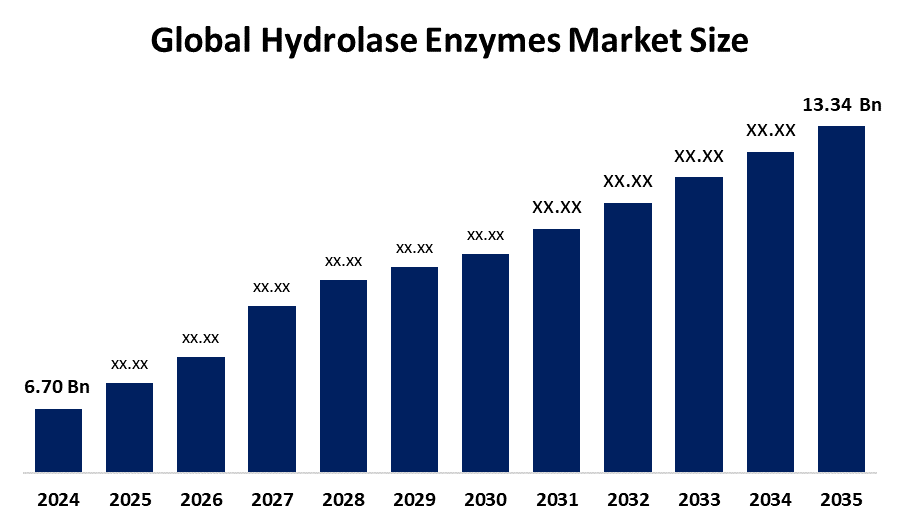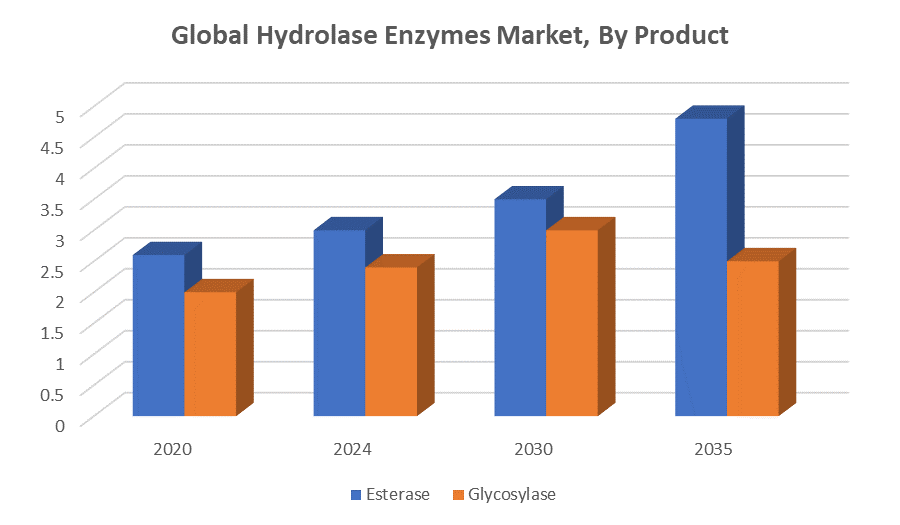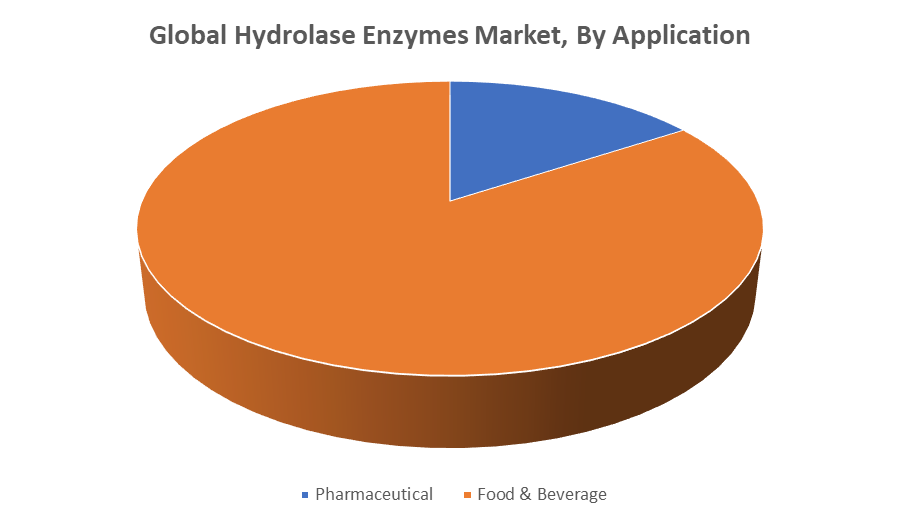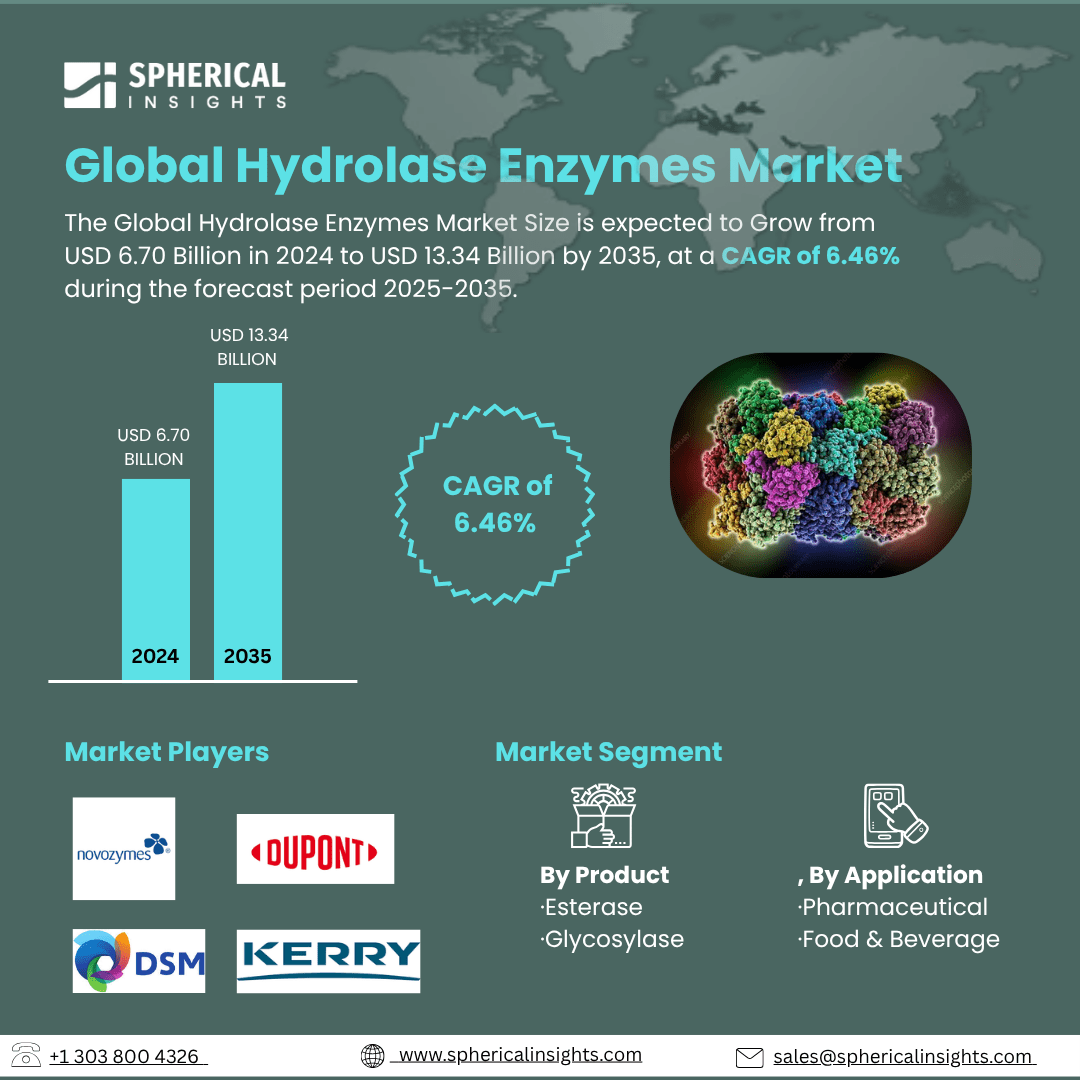Global Hydrolase Enzymes Market Insights Forecasts to 2035
- The Global Hydrolase Enzymes Market Size Was Estimated at USD 6.70 Billion in 2024
- The Market Size is Expected to Grow at a CAGR of around 6.46% from 2025 to 2035
- The Worldwide Hydrolase Enzymes Market Size is Expected to Reach USD 13.34 Billion by 2035
- Europe is expected to grow the fastest during the forecast period.

Hydrolase Enzymes Market
The hydrolase enzymes market focuses on enzymes that catalyze the hydrolysis of chemical bonds, facilitating the breakdown of complex molecules such as proteins, lipids, and carbohydrates into simpler components. These enzymes, including proteases, lipases, and amylases, are integral to multiple industries like food and beverages, pharmaceuticals, detergents, and biofuels. Hydrolase enzymes improve processing efficiency, product quality, and functionality by accelerating biochemical reactions. They are widely used in food processing to enhance texture and flavor, in detergents for effective stain removal, and in pharmaceuticals for drug development and formulation. Technological advancements have improved enzyme stability and specificity, expanding their industrial applications. The market comprises both natural and engineered enzymes, catering to diverse industrial needs. Overall, hydrolase enzymes play a vital role in industrial biotechnology, offering eco-friendly and cost-effective solutions that support sustainable production processes across various sectors.
Attractive Opportunities in the Hydrolase Enzymes Market
- Increasing research in enzyme engineering and synthetic biology enables the creation of tailored hydrolase enzymes with enhanced performance and specificity, meeting the unique needs of diverse industrial applications.
- Emerging fields like environmental bioremediation and waste management offer new avenues for hydrolase enzymes to help address global sustainability challenges by breaking down pollutants and organic waste efficiently.
- The rising trend of personalized medicine creates opportunities for hydrolase enzymes in targeted drug delivery systems and diagnostic tools, enhancing treatment effectiveness and patient outcomes.
Global Hydrolase Enzymes Market Dynamics
DRIVER: Hydrolase enzymes offer a natural and biodegradable alternative to chemical catalysts
Hydrolase enzymes offer a natural and biodegradable alternative to chemical catalysts, appealing to industries aiming to reduce their environmental impact. The rising use of these enzymes in food and beverage processing, pharmaceuticals, and detergents enhances product quality and efficiency, further fueling market expansion. Additionally, advancements in biotechnology have enabled the development of more stable and specific enzyme variants, broadening their industrial applicability. The growing pharmaceutical sector’s interest in enzyme-based therapies and diagnostics also contributes to market growth. Moreover, the surge in biofuel production, which relies heavily on enzymatic hydrolysis, is creating substantial demand for hydrolase enzymes. Increased consumer awareness about the benefits of enzyme-based products and stricter environmental regulations encouraging green technologies also act as significant drivers, collectively propelling the global hydrolase enzymes market forward.
RESTRAINT: High production cost associated with enzyme manufacturing
One major challenge is the high production cost associated with enzyme manufacturing, which can limit their affordability and adoption, especially for small and medium-sized enterprises. Additionally, enzyme stability remains a concern, as hydrolases often lose activity under extreme pH, temperature, or industrial processing conditions, reducing their effectiveness in certain applications. The complexity of enzyme purification and formulation processes also adds to operational challenges and expenses. Furthermore, the availability of synthetic chemical alternatives, which are often cheaper and more stable, poses competition to hydrolase enzymes in some sectors. Regulatory hurdles and lengthy approval processes for enzyme-based products, particularly in pharmaceuticals and food industries, can delay market entry and increase costs. Lastly, limited awareness or lack of technical expertise among end-users about enzyme benefits can hinder broader market penetration, particularly in developing regions. These factors collectively restrain the rapid expansion of the hydrolase enzymes market.
OPPORTUNITY: Expanding applications in emerging fields
Increasing research in enzyme engineering and synthetic biology offers the potential to create customized hydrolases with enhanced performance tailored for specific industrial needs. Expanding applications in emerging fields such as waste management and environmental bioremediation open new avenues for hydrolase use, helping to address global sustainability challenges. The rising trend of personalized medicine also creates opportunities for hydrolase enzymes in targeted drug delivery and diagnostics. Moreover, growing interest in plant-based and alternative protein products in the food industry is driving demand for enzymes that improve texture and digestibility. Collaborations between biotech firms and academic institutions can accelerate innovation, enabling the development of cost-effective and robust enzyme solutions. Lastly, the increasing adoption of green chemistry principles in various sectors encourages the replacement of harsh chemicals with enzymatic processes, broadening the market potential for hydrolase enzymes across diverse industries.
CHALLENGES: Scalability of enzyme production
One significant challenge is the scalability of enzyme production, as moving from laboratory-scale to industrial-scale manufacturing can be complex and resource-intensive. Ensuring consistent enzyme quality and activity at large volumes requires advanced bioprocessing technologies and stringent quality control. Intellectual property rights and patent issues can also limit the availability of novel enzyme variants, slowing innovation and market entry. Additionally, the integration of enzymes into existing industrial processes often demands process redesign and optimization, which can be time-consuming and costly for companies. There is also a knowledge gap in some industries regarding the optimal use and handling of hydrolase enzymes, leading to underutilization or ineffective application. Lastly, the variability in raw materials used in enzyme production, such as microbial strains or substrates, can affect enzyme performance and reliability, posing further operational challenges to manufacturers and end-users alike.
Global Hydrolase Enzymes Market Ecosystem Analysis
The global hydrolase enzymes market ecosystem includes enzyme manufacturers producing proteases, lipases, and amylases using microbial fermentation and biotechnology. Raw material suppliers provide essential inputs like microbial strains and substrates. Research institutions drive innovation in enzyme engineering and production. Regulatory bodies ensure safety and quality standards. Distributors manage global supply chains, delivering enzymes to key end-use industries such as food, pharmaceuticals, detergents, and biofuels. Service providers offer formulation and technical support, helping optimize enzyme applications across diverse sectors.
Based on the product, esterases dominated the hydrolase enzymes industry with the highest revenue share over the forecast period

Esterases dominated the hydrolase enzymes industry, holding the highest revenue share throughout the forecast period. This dominance is attributed to their wide range of applications, including in pharmaceuticals, food processing, detergents, and biofuel production. Esterases efficiently catalyze the hydrolysis of ester bonds, making them highly valuable for processes requiring specificity and effectiveness. Their versatility and efficiency have driven strong demand, contributing significantly to the overall revenue growth of the hydrolase enzymes market during the forecast period.
Based on the application, food & beverage dominated with a leading revenue share during the forecast period

The food and beverage sector dominated the hydrolase enzymes market, capturing the leading revenue share during the forecast period. This is due to the extensive use of hydrolase enzymes like proteases, amylases, and esterases in improving food texture, flavor, and shelf life. These enzymes aid in processes such as protein hydrolysis, starch breakdown, and fat modification, enhancing product quality and processing efficiency. The growing demand for processed and functional foods continues to drive the adoption of hydrolase enzymes in this industry, fueling market growth.
North America is anticipated to hold the largest market share of the hydrolase enzymes market during the forecast period
North America is anticipated to hold the largest market share in the hydrolase enzymes market during the forecast period. This leadership is driven by the region’s well-established food and beverage, pharmaceutical, and biofuel industries that extensively utilize hydrolase enzymes. Advanced biotechnology infrastructure, significant research and development investments, and strong regulatory support further bolster market growth. Additionally, growing consumer awareness about enzyme-based products and increasing demand for sustainable and eco-friendly solutions contribute to North America’s dominant position in the global hydrolase enzymes market.
Europe is expected to grow at the fastest CAGR in the hydrolase enzymes market during the forecast period
Europe is expected to grow at the fastest CAGR in the hydrolase enzymes market during the forecast period. This rapid growth is driven by increasing adoption of enzyme-based solutions across industries such as food and beverages, pharmaceuticals, and detergents. Strong focus on sustainable and eco-friendly manufacturing practices, along with supportive government regulations promoting green technologies, further accelerate market expansion. Additionally, ongoing investments in research and development and rising consumer demand for high-quality, enzyme-enhanced products contribute to Europe’s leading growth rate in the hydrolase enzymes market.
Recent Development
- In May 2023, DSM launched Maxilact Next, a highly efficient lactase enzyme that reduces hydrolysis time by 25% compared to previous market references. This product enables lactose-free dairy producers to optimize production and improve raw material efficiency without compromising taste.
- In April 2021, Biocatalysts Ltd. introduced Promod 517MDP (P517MDP), an exopeptidase enzyme that hydrolyzes over 40% of casein protein into smaller peptides and amino acids. This innovation enhances the solubility and digestibility of dairy proteins, making it suitable for specialized medical foods and infant formulas.
Key Market Players
KEY PLAYERS IN THE HYDROLASE ENZYMES MARKET INCLUDE
- Novozymes A/S
- DuPont
- DSM
- Kerry Group plc
- BASF SE
- Biocatalysts Ltd.
- Advanced Enzymes Technologies Ltd.
- Amano Enzyme Inc.
- AB Enzymes GmbH
- Codexis, Inc.
- Others
Market Segment
This study forecasts revenue at global, regional, and country levels from 2020 to 2035. Spherical Insights has segmented the hydrolase enzymes market based on the below-mentioned segments:
Global Hydrolase Enzymes Market, By Product
Global Hydrolase Enzymes Market, By Application
- Pharmaceutical
- Food & Beverage
Global Hydrolase Enzymes Market, By Regional Analysis
- North America
- Europe
- Germany
- UK
- France
- Italy
- Spain
- Russia
- Rest of Europe
- Asia Pacific
- China
- Japan
- India
- South Korea
- Australia
- Rest of Asia Pacific
- South America
- Brazil
- Argentina
- Rest of South America
- Middle East & Africa
- UAE
- Saudi Arabia
- Qatar
- South Africa
- Rest of the Middle East & Africa






